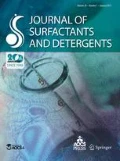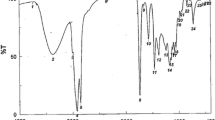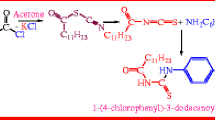Abstract
Nonionic surfactants have a number of applications because they are effective in hard water, maintain their integrity in acidic, neutral, and basic media, show favorable skin compatibility, and can be formulated with ionic surfactants. Thus, spurred on by their favorable characteristics, a novel candidate of this class, 1-butyl-3-dodecanoylthiourea, was synthesized in high yield. The structure was characterized by 1H-NMR, 13C-NMR, FTIR and UV–vis spectroscopy. This surfactant demonstrated very low solubility in water and sub-millimolar critical micelle concentrations (CMC) in ethanol and hexane, signifying that they are reasonably amphiphobic. This thio-urea based surfactant shows corrosion inhibition of metals like chromium and aluminum.





Similar content being viewed by others
References
Salager JL (2002) Surfactants: types and uses-teaching aid in surfactant science and engineering, Laboratory of Formulation, Interfaces, Rheology, and Processes, Version#2 FIRP Booklet-E300-A- Universidad De Los Andes. Merida, Venezuela
Smith EE, Perks S (2010) A perceptual study of the impact of green practice implementation on the business functions. South Afr Bus Rev 14(3):1–29
Xu B, Han F, Shui J, Zhou Y (2007) Synthesis and characterization of lauryl trimethyl ammonium surfactants with new counteranion types. J Surf Deterg 12:351–354
Bulatovic SM (2007) Handbook of flotation reagents: chemistry theory and practice, 1st edn. Elsevier, Boston
Saeed S, Hussain R (2013) A convenient way for the preparation of novel thiourea derivatives containing biologically active quinazoline moiety. Eur Chem Bull 2:465–467
Park SH, Wei S, Mizaikoff B, Taylor ET, Favaro C, Huang CH (2009) Degradation of amine-based water treatment polymers during chloramination as N-nitrosodimethylamine (NDMA) precursors. Environ Sci Technol 43:1360–1366
Kandeel EM (2011) Synthesis and performance of glycerol ester-based nonionic surfactants. Der Chem Sinica 2(3):88–98
Seifert K, Domka F (2005) Inhibiting effect of surfactants and heavy metal ions on the denitrification process. Pol J Environ Stud 14(1):87–93
Qu G, Cheng J, Wei J, Yu T, Ding W, Luan H (2011) Synthesis, characterization and surface properties of series sulfobetaine surfactants. J Surf Deterg 14:31–35
Aldrich C, Feng D (2000) Removal of heavy metals from wastewater effluents by biosorptive flotation. Miner Eng 13:1129–1134
Holmberg K, Jonsson B, Lindman B, Lindman B (2003) Surfactants and polymers in aqueous solution, 2nd edn. Wiley, New Jersey
Zhou W, Li B, Zhu L, Ding J, Zhang Y, Lu L, Yang X (2004) Structural and spectral studies on N-(4-chloro) benzoyl-N′-(4-tolyl)thiourea. J Mol Struct 690:145–150
Eweis M, Elkholy SS, Elsabee MZ (2006) Antifungal efficacy of chitosan and its thiourea derivatives upon the growth of some sugar-beet pathogens. Int J Bio Macromol 38:1–8
Ullah I, Shah A, Badshah A, Shah A, Shah NA, Tabor R (2015) Surface, aggregation properties and antimicrobial activity of four novel thiourea-based non-ionic surfactants. Coll Surf A 464:104–109
Ullah I, Shah A, Badshah A, Rana UA, Shakir I, Khan AM, Khan SZ, Rehman Z (2014) Synthesis, characterization and investigation of different properties of three novel thiourea-based non-ionic surfactants. J Surf Deterg 17:1013–1019
Ullah I, Naveed A, Shah A, Badshah A, Rehman Z, Shahzada Khan G, Nadeem A (2014) High yield synthesis, detailed spectroscopic characterization and electrochemical fate of novel cationic surfactants. J Surf Deterg 17:243–251
Schnidman L (1933) The solubility of thiourea in water, methanol, and ethanol. J Phys Chem 37:693–700
Tabor RF, Gold S, Eastoe J (2006) Electron density matching as a guide to surfactant design. Langmuir 22:963–968
Acknowledgments
The authors gratefully acknowledge the financial support of Higher Education Department Khyber Pakhtunkhwa, Higher Education Commission Islamabad, Pakistan, and School of Chemistry, Monash University, Australia.
Author information
Authors and Affiliations
Corresponding author
About this article
Cite this article
Ullah, I., Shah, A. & Khan, M. Synthesis, Surface Properties, and Corrosion Inhibition of 1-Butyl-3-dodecanoylthiourea. J Surfact Deterg 19, 873–877 (2016). https://doi.org/10.1007/s11743-016-1836-5
Received:
Accepted:
Published:
Issue Date:
DOI: https://doi.org/10.1007/s11743-016-1836-5




